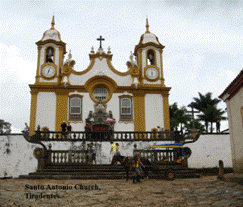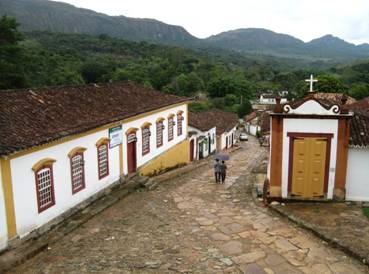Soaking wet on the Gold Diggers’ Trail
Minas Gerais
In Brazil, Carnivals are usually drenched; Carnival 2011 was no exception. Rain or shine, carnivals are nonetheless celebrated with equal fervor. I decided to escape the chaos of street carnival in Rio de Janeiro and fly to the colonial towns of São João del-Rei and Tiradentes located on the Old Gold Trail in Minas Gerais. The state de Minas Gerais (MG) endured non-stop rain during the four-day long holidays.
Consequently my trip started badly. The rain was so heavy over São João del-Rei that the small propeller plane couldn’t land and skipped the stop-over. It finally landed in Belo Horizonte, the capital of MG. We then drove back to São João del-Rei. With heavy traffic and a wet road, the 180 kms drive lasted four hours.
Gold was discovered at the end of the 17th century in several rivers in a rough wilderness of forests and mountains some 300 kms as the crow flies north of Rio. Mining gave its name to the state: Minas Gerais means General Mines in Portuguese. Gold mining was a gift to Brazilian architecture; it offered Brazil some of its most charming colonial towns namely Ouro Preto, Mariana, Sabará, Congonhas, São João del-Rei and Tiradentes. The first trail to link the gold mining areas to the sea for shipment to Portugal became known as the Caminho velho, or the Old Trail. It linked the town of Ouro Preto in MG to the port of Paraty south-west of Rio de Janeiro.

Two decades later, a new and shorter trail, caminho novo was opened to reach the city of Rio de Janeiro. When diamonds were discovered in the region of Diamantina 380 kms north of Ouro Preto the new trail was extended to reach the diamond fields. The old and new trails make up the 1605 kms long Estrada Real, or Royal Highway. The trails are still partially paved.
Tiradentes, Diamantina and the small quaint port of Paraty are my favorite colonial towns. When gold and diamonds became exhausted at the beginning of the end of the 18th century, these towns were left to their fates. They don’t quite qualify as mining ghost towns, but they were passed over by development and nearly forgotten for over hundred years. Tiradentes and Paraty are located on the old gold trail. Their long economic slumber preserved their baroque-style architecture, and the atmosphere of the quaint streets. The cities’ unspoiled colonial heritage makes them particularly attractive to tourists. During this very wet 2011 carnival, Tiradentes was drenched by rain and flooded by tourists from all over Brazil.
The easiest and more comfortable way to visit Tiradentes is to fly* to São João del-Rei which is 12 kms from Tiradentes. São João is a very prosperous city which weathered the gold bust by finding economic alternatives such as trade, agriculture and industry. One would think that this reconversion obliterated its colonial heritage, but this not so. The town is worth a visit; many of its remarkable cultural sites are well preserved notably in the small colonial center. The colonial 18th century is well illustrated by five impressive baroque churches and several mansions referred to as solares in Portuguese. It also displays ornate and colorful early 20th century Belle Epoque architecture legacy of its continuous prosperity.

The family house of São João’s famous son Tancredo de Almeida Neves is particularly attractive (left). Tancredo as he is affectionately known in Brazil was democratically elected president in 1985 after two decades of military dictatorship. Sadly, he was never officially president as he died before taking the oath of office. Across the street from Tancredo’s solar, one can visit the house of another famous member of the Neves family, that of Tancredo’s cousin Lucas Cardinal Moreira Neves. Lucas Neves was considered a serious papal contender to replace John Paul II. He was a descendant of slaves on his mother side. Unfortunately the Neveses’ brilliant prospects were defeated by their respective poor health. Don Lucas died two years before the pope he was tipped to succeed. It is not all lost for the Neves dynasty. The young, dynamic and good looking Aécio Neves, former Governor of MG and now a federal senator, could become the candidate of the opposition for the 2014 presidential election. Thanks God, Aécio seems to be in very good health!
One cannot leave São João without visiting its five splendid churches. Two are notably stunning, São Francisco de Assis, and Nossa Senhora do Pilar; known as matriz, equal to a cathedral. The later has a statue which required 12 kilos of gold, countless diamonds and emeralds.
It is too bad the rain drenched the street carnival. São João is renowned for its old fashioned parades, which are a healthy antidote to the high-tech, over-the-top samba schools parades of Rio. São João is also famous for its white rum cachaça and its pewter artifacts. Although tin is no longer mined in the region, the pewter industry survived. Mineiros, as the inhabitants of MG are known pride themselves as cachaça connoisseurs. Hundreds of brands of hand crafted cachaças can be purchased in selected stores. My favorite brand is the famed Cachaça do Beethoven. There is a very simple explanation to this incongruous name; it is the name of its owner. Beethoven da Silva or Beethoven Sousa Perreira, who knows?
The most exotic means of transportation between São João and Tiradentes is with the famous Maria Fumaça, or Smoky Mary, the grand old dame of steam locomotives. The one which I took was built in the United States of America in 1912. The 12 kms ride takes about 35 minutes; Maria Fumaça leisurely slithers through the suburbs of São João del-Rei; there are no railway crossing barriers, and the whistle warms car drivers of the incoming train. It is such a beloved attraction that even local people wave at Maria’s passage.
The train rides alongside the Rio das Mortes, or River of the Dead. The river owes its creepy name to the deadly battles between the rag tag explorers and gold diggers from São Paulo, called the bandeirantes, and the Portuguese gold prospectors. Gold had been discovered by the former in 1702. The town of Tiradentes owes its name to Joaquim José da Silva Xavier who was born in the vicinity. Tiradentes (pull teeth in Portuguese) was his nick-name as he occasionally practiced as a dentist. Tiradentes became a republican hero for having, at the time of the French revolution, raised a small army of followers against the Portuguese colonial government. He was hanged in Rio in 1792.
Even during its gold digging heydays in the 1700s, Tiradentes never compared with elegant towns like São João del-Rei or Ouro Preto. It has retained its charming rustic feel; its streets are still paved with big uneven stone slabs known as pé-de-moleque in Portuguese, because only bare foot street urchins could manage this rough pavement. Its main church, Santo Antonio, has an unassuming façade. However half a ton of gold was used to cover the rococo engravings and carving of its nave. The choir displays a beautiful Portuguese organ dating from 1779, and which is still working.

My favorite church is Nossa Senhora do Rosario dos Pretos which, legend has it was built at night by slaves using gold dust smuggled under their finger nails. The church is modest in size but displays a beautifully painted ceiling. At the time of the gold rush the Africans, slaves or free men, made up 70 percent of the population of the settlement.
Now Tiradentes is going through a second golden age, that of tourism. The main attractions of Tiradentes are music and religious festivals, handicrafts, boutique hotels, gastronomy and eco-tourism. The village has become a large craft emporium selling folk art, textiles and furniture made out of salvaged wood* in the neighboring village of Bichinho. During this carnival, hordes of tourists, their dripping umbrellas in one hand and wallet in the other, were busy raiding the many small shops in search of the perfect souvenir. Restaurants seem to be opened 24 hours a day! Since my last visit three years ago, many have now become “kilo” restaurants, selling food by weight. “Kilo” is the Brazilian response to buffet meals.

Tiradente should be avoided during tourism hustle bustle times such as carnival and Holy Week when Cariocas, the inhabitants of Rio; Paulistas those of São Paulo; and Mineiros mainly from Belo Horizonte descend on the city. Tiradente is best enjoyed when empty, the way it was when it went into oblivion, isolated from the aggression of economic development.
The sun came out the day of my departure. The plane landed safely and we took off for Rio, a thirty minute flight.
Beatrice Labonne, Rio de Janeiro, March 13, 2011.
*TRIP airline flies from Rio de Janeiro’s Santos Dumond airport.
|

![]()